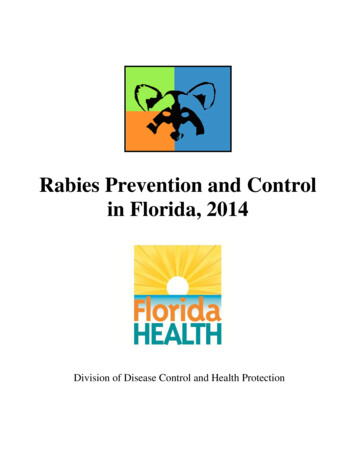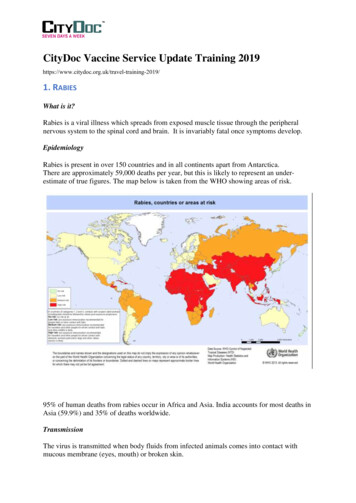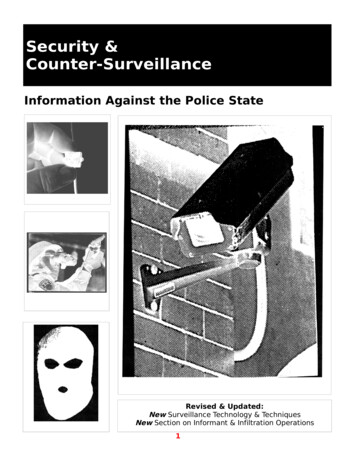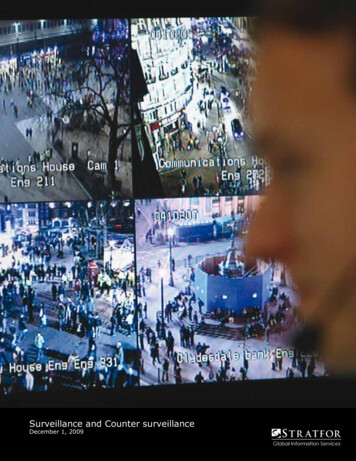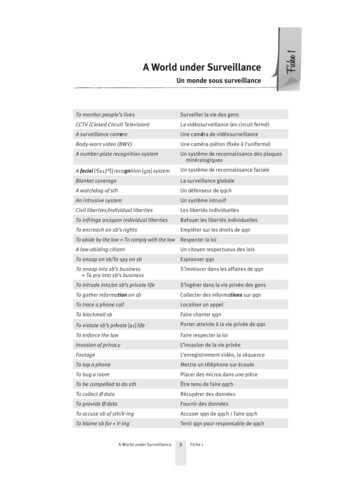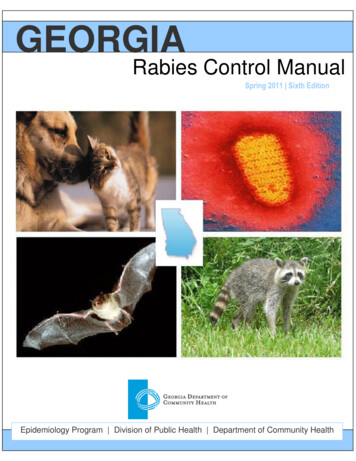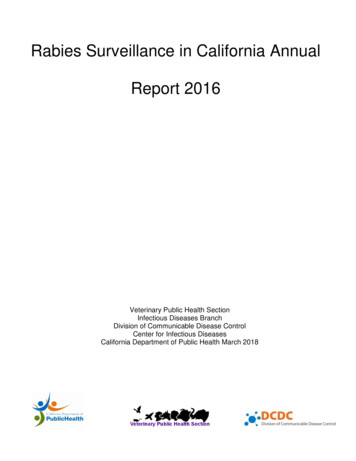
Transcription
Rabies Surveillance in California AnnualReport 2016Veterinary Public Health SectionInfectious Diseases BranchDivision of Communicable Disease ControlCenter for Infectious DiseasesCalifornia Department of Public Health March 2018
Rabies Surveillance in California, 2016IntroductionRabies is a severe zoonotic encephalitis caused by a Rhabdovirus of the genus Lyssavirus.Following a variable incubation period that can range from one week to several years, earlyclinical signs and symptoms of rabies--including headache, fever, chills, cough or sore throat,anorexia, nausea, vomiting, and malaise--are non-specific and can be mistaken for morecommon conditions. Disease progresses rapidly (within 1-2 weeks) to central and peripheralneurologic manifestations including altered mental status (e.g., hyperactivity and agitation),irritation at the site where the virus was introduced, hydrophobia, excessive salivation, anddifficulty swallowing due to laryngeal spasms. Ultimately, autonomic instability, coma, anddeath occur, due mainly to cardiac or respiratory failure. No treatment protocol has provenconsistently effective for clinical rabies and reports of patients surviving are exceedingly rare. Ifa person is exposed to the virus, prompt post-exposure prophylaxis (PEP) by administration ofrabies immune globulin and vaccine can prevent progression to clinical rabies.Rabies virus variants (RABVV) are maintained in certain mammalian species, but all rabiesviruses are capable of infecting any mammal, including humans. In California, bat RABVVsexist throughout the state, while the California skunk RABVV is found mostly north of theTehachapi mountain range. Domestic animals (dogs, cats, and livestock) can be infected withthese RABVVs through contact with rabid wildlife; but the rarity of domestic animal rabies inCalifornia limits the potential for the virus to evolve and sustain transmission in these species.Each year since 1957, the Director of the California Department of Public Health (CDPH) hasidentified counties in California where rabies constitutes a public health hazard. The Directorhas declared all 58 counties in California as rabies areas every year since 1987.Since the early 20th century, CDPH has overseen a statewide rabies surveillance and controlprogram. Local departments of public health and environmental health, animal control agenciesand shelters, and medical and veterinary practitioners collaborate with CDPH to prevent rabiesin California by: Providing reliable laboratory services for the diagnosis of rabies in humans and animals, Regulating and enforcing rabies vaccination of dogs to provide a protective“firewall” that reduces the potential for human exposure, Investigating reports of animals that bite humans, Evaluating animals for rabies by confinement and observation for a specified period, oreuthanasia and testing, Offering recommendations for PEP to persons following a known or suspected exposure torabies, Developing and disseminating preventive education on rabies, and Collecting, collating, and reporting surveillance data on rabies in humans and animals.Reporting and AnalysisThe California Code of Regulations (17 CCR §2500) lists rabies that is diagnosed in eitherhumans or animals as a reportable disease. Health care providers, including physicians andveterinarians, having knowledge of a confirmed or suspected case of rabies are required toreport this knowledge immediately to the local health officer. Diagnostic testing of humanpatients with signs and symptoms suggestive of rabies is particularly challenging, and no singletest can accurately diagnose rabies ante-mortem. Therefore, several tests on multiple tissuesamples are typically pursued. Diagnosis can be made by detection of virus antigen in nuchal2
Rabies Surveillance in California, 2016skin biopsy, brain biopsy, or saliva by direct fluorescent antibody assay (DFA) or polymerasechain reaction; or by demonstration of rabies-specific antibodies in blood or cerebrospinal fluidby immunofluorescent antibody assay or Rapid Fluorescent Focus Inhibition Test (RFFIT).Infection with rabies is confirmed post-mortem in humans and animals by detection of rabiesvirus antigen, typically in central nervous system tissue, by DFA performed by a certified publichealth microbiologist. In 2016, 34 local public health laboratories in California employed trainedmicrobiologists and maintained resources to perform rabies testing in animals. The CDPH Viraland Rickettsial Diseases Laboratory (VRDL) provides primary and confirmatory testing for rabiesin animals, diagnostic testing of suspect rabies human patients, and characterization of rabiesviruses to variant type. Local public health departments report confirmed cases of rabies inhumans and animals to CDPH. This surveillance report summarizes information on human andanimal rabies cases reported to CDPH in 2016.Rabies in AnimalsIn 2016, specimens from 5,355 animals were tested for rabies in California – approximately 15percent fewer than the annual average of 6,288 specimens tested during the previous ten years,2006-2015. Of the 56 counties that tested at least one animal for rabies, the number of animalstested per county ranged from 1 to 676.Rabies was confirmed in 226 animals, similar to the 230 cases confirmed in 2015 andslightly above the annual average of 207 cases in the previous ten years, 2006-2015. Oneor more rabid animals were identified in 42 counties (Table 1), which reported between 1and 38 rabid animals each.Wild AnimalsRabies was diagnosed in 220 wild animals in 2016, accounting for 97 percent of all rabidanimals reported to CDPH. Bats (176, 77.9%) were the wild animal most frequently reportedrabid, followed by skunks (32, 14.2%) and foxes (12, 5.3%).BatsA total of 1,536 bats from 55 counties were tested for rabies in 2016 (Figures A, B). The 176rabid bats reported in 2016 is comparable to the annual average of 172 reported in the previousten years, 2006-2015 (Figure C). The greatest number of rabid bats (38) was reported in LosAngeles County, which reported the most rabid bats in eight of the past ten years. The sixsouthern California counties of Los Angeles, Orange, Riverside, San Bernardino, San Diego,and Ventura collectively accounted for 45 percent of all rabid bats detected in California in 2016(Figure B). Rabid bats were most frequently reported during late summer and early autumn;over half of all rabid bats (98, 56%) were reported in the four months from July through October(Figure D). Information on species was reported for 13 rabid bats: 8 Mexican free-tailed bats(Tadarida brasiliensis), 1 big brown bat (Eptesicus fuscus), 2 Myotis sp., 1 long-eared myotis(Myotis evotis), and 1 Canyon bat (Parastrellus hesperus).SkunksA total of 354 skunks from 37 counties were tested for rabies in 2016, of which 32 from 7counties were confirmed (Figure E). The 32 rabid skunks in 2016 was greater than the annualaverage of 26 in the preceding ten years, 2006 - 2015. The greatest number of rabid skunks(12) was reported in El Dorado County. Nearly one third (10, 31%) of the rabid skunks in 2016were identified in August and September.3
Rabies Surveillance in California, 2016FoxesA total of 51 foxes from 17 counties were tested for rabies in 2016. The 12 rabid foxes confirmedin 2016 is an increase from the annual average of 7 foxes reported in the previous 10 years,2006–2015 (Figure C).Domestic AnimalsIn 2016, 2,876 domestic animals (dogs, cats, horses, cattle, goats, and sheep) were tested forrabies. Rabies was confirmed in three dogs and three cats, notably more than the mean of 1.1domestic animal rabies cases per year in the previous ten years, 2006-2015.In February 2016, a two-year-old male English bulldog from Amador County presented to aveterinary clinic with 24 hours lethargy and dysrexia. Upon examination, the dog was noted tohave difficulty closing its mouth. The dog was released home without further workup, but returnedto the clinic three days later with dropped jaw, excessive salivation, hind limb weakness, andrespiratory distress. The dog was euthanized and rabies virus was detected in brain tissue by theEl Dorado County Public Health Laboratory. The VRDL identified the virus as consistent with theCalifornia skunk RABVV; the owner reported that the dog was sprayed by a skunk approximatelyone month prior to onset, but no wounds or other signs of injury were noted at that time. Thedog’s previous owner was located and stated he had administered a rabies vaccine to the dog athome on an unspecified date. Three other animals in the rabid dog’s current household–one dogand two cats–were given vaccine boosters and ordered into six-month confinement. A total of 13individuals who had contact with the dog--including household family members, neighbors, andveterinarian staff—were advised to receive rabies PEP.In July 2016, an 11-month-old male Rhodesian Ridgeback-mix dog from Humboldt Countypresented to a veterinary clinic after developing lameness and hypersalivation. While at theclinic, the animal showed signs of aggression and was euthanized. Rabies virus was detected inbrain tissue at VRDL. The dog had been vaccinated against rabies approximately 20 monthsprior to onset, but was overdue for its booster dose. The dog was observed attacking a skunkapproximately one month prior to onset. Two other dogs in the household that also had contactwith the skunk were re-vaccinated and placed into confinement. Of 13 persons evaluated forpossible contact with the dog, rabies PEP was recommended for 6.In November 2016, an unvaccinated six-month-old male “pitbull-type” dog from CalaverasCounty presented to a veterinary clinic with history of 24-48 hours of unspecified illness. The dogdied while at the veterinary clinic and the body was released to the owners who buried it on theirproperty. Following notification by the veterinarian, Calaveras County Animal Services disinterredthe carcass and submitted the brain to San Joaquin County Public Health Laboratory for rabiestesting. Infection with rabies virus was confirmed four days after the dog’s original presentation.At least 17 other dogs, cats, and livestock shared property with the rabid dog; none had beenpreviously vaccinated against rabies. All animals were euthanized except for three horses thatwere vaccinated and placed in extended confinement. Nine persons who had contact with thedog –the owner, members of the owner’s family, and veterinary staff – were evaluated forpossible exposure to rabies virus. Rabies PEP was initiated for six of these persons.In September, a free-roaming cat of unknown age, sex, and vaccination status from HumboldtCounty was killed by an individual who had been feeding it and noticed a change in the animal’s4
Rabies Surveillance in California, 2016behavior. The deceased cat tested positive for rabies at Humboldt County Public HealthLaboratory. The rabid cat had shared the location with approximately 20 other cats, 15 of whichAnimal Control collected and euthanized following the positive rabies result. The individual whokilled the cat declined rabies PEP, having completed PEP following a bite from a fox in August2017.In November, an unvaccinated, two-year-old spayed cat was taken to a veterinary clinic in ContraCosta County after reportedly biting and scratching two household members, inflicting multiplewounds on their hands and feet. Because the cat lived exclusively indoors, rabies was notsuspected and the cat was released home. The next morning, the owner notified the veterinaryclinic that the cat had died overnight following sudden onset of paralysis. County animal controlstaff collected and delivered the cat to Contra Costa Public Health Laboratory for testing, whichconfirmed rabies. Rabies PEP was recommended to five household members, one familyassociate, and two veterinary clinic staff.Also in November, an approximately seven-month-old kitten, acquired as a stray, was presentedto a veterinary clinic in Sacramento County due to ataxia. The animal had been spayed andgiven a rabies vaccine a few days earlier. The veterinarian euthanized the animal and submittedit to the Sacramento County Public Health Laboratory for testing, which confirmed rabies. RabiesPEP was recommended to four family members and four veterinary staff. Other households inthe community were apprised of the rabies detection and advised to notify public health officials ifthey had any contact with the cat, and to ensure that their pets were up to date on their rabiesvaccinations.Rabies in HumansRabies was not diagnosed in any California residents in 2016. Four cases of rabies werediagnosed in California residents in the previous ten years (2006- 2015), the most recent ina Contra Costa County resident in 2012.Rabies in the United StatesThe U.S. Centers for Disease Control and Prevention (CDC) had not published national rabiesdata for 2016 at the time this report was prepared.DiscussionBats were the most frequently reported rabid animal in California in 2016, as they have beeneach year since 2000. Over the last 15 years, the number of rabid bats has ranged from a lowof 137 (2008) to a high of 227 (2012), accounting for 62 to 95 percent of all rabid animalsidentified. Rabies viruses have evolved to include several RABVVs that are efficientlytransmitted between bats of a given species. The widespread distribution of innumerable batssharing intimate roosting space ensures that these well-adapted viruses will perpetuateindefinitely in California bat colonies. As in previous years, most rabid bats in 2016 weredetected in the late summer and early autumn—a time when juvenile bats are leaving the roostsfor the first time and adult bats are initiating pre-winter migration or search for winter roosts andhibernacula. The proportion of bats that tested positive for rabies in 2016 (176 of 1,536, 11.5%)is slightly lower than that reported in 2015 (13.4%) and comparable to the proportion identifiedin 2014 (11.6%). Although confined by the limitations of a passive surveillance system, thesedata suggest that while minor annual fluctuations exist in the dynamics of rabies infection inbats, the prevalence of bat rabies in California remains fairly stable from year to year.5
Rabies Surveillance in California, 2016Reported cases of skunk rabies in California have decreased markedly over the past fewdecades (Figure F). In 1985, 402 cases of skunk rabies were reported, but this number droppedto below 100 in 2000, and to less than 50 by 2003. In the last ten years, an average of 25 skunkrabies cases are reported each year, making skunks the second most commonly identified rabidanimal in California. A unique RABVV circulates in California skunks in certain historicallyrecognized enzootic regions. Roughly three quarters of all rabid skunks in 2016 were reportedfrom three western Sierra Nevada foothill counties: Amador, El Dorado, and Calaveras. Fifty-sixpercent of skunks from these three counties tested for rabies in 2016 were positive (23 positiveof 41 skunks tested), compared to 40 percent in 2014 and 2015. It is unknown if this modestincrease in 2016 represents a true higher incidence of rabies in skunks, changes in theselection criteria for skunks submitted for testing, or normal fluctuation within the broad marginof error inherent in a passive surveillance system.Twelve rabid foxes were reported in 2016, compared to none in 2015 and a ten-year averageof seven foxes. (Figure C). Ten or fewer rabid foxes were reported in California each yearsince 1994, with the exception of 2009 when an epizootic in Humboldt County contributed to 38of the 41 rabid foxes reported in California that year. In 2016, seven rabid foxes were reportedfrom northern coastal counties (Humboldt, Mendocino, Sonoma) and three rabid foxes from thewestern Sierra Nevada (Amador, El Dorado, Mariposa counties). Of particular note wasdetection of rabies in a desert kit fox in eastern Imperial County. This was the first report ofrabies in a wild or domestic canid in Imperial County since 1981. Because of the rarity of rabiesin wild and domestic canids in Imperial County, and the proximity of the location where therabid fox was collected to both inter-state and international borders, there was concern that thiscase might represent the introduction into California of a novel terrestrial (i.e., non-batassociated) RABVV. Fortunately, the RABVV infecting this kit fox was identified as consistentwith Mexican free-tailed bat RABVV—one of the most common RABVVs in California andthroughout the United States.Throughout the history of rabies in North America, a canine RABVV represented thepredominant strain in circulation. In the early half of the 20th century, upwards of 1000 cases ofrabies were identified each year in California dogs, cats, and livestock. Because domestic dogswere frequently affected, the risk of rabies infection for humans was also several fold greaterthan it is today. Over 100 California residents were diagnosed with rabies in the first half of the20th century. In the 1940s and 1950s, development and marketing of effective veterinary rabiesvaccines, combined with mandated animal control, vaccination, and licensure laws,successfully slowed and eventually interrupted the transmission of canine RABVV in NorthAmerica. By the 1970s, the number of rabid dogs in California had declined from severalhundred each year to fewer than 10. In 2008, CDC declared the canine RABVV eradicatedfrom the United States. Cases of rabies in domestic and wild canids in California and most ofthe U.S. now chiefly represent incidental spillover of other terrestrial (raccoon, skunk) or volant(bat) RABVVs.However, RABVVs adapted to wild canids have been observed in some areas of the UnitedStates: a dog-coyote variant in southern Texas along the U.S.-Mexico border, a grey foxvariant in central Texas, a different grey fox variant in Arizona, and an Arctic fox variant inAlaska. These wild canine RABVVs present a risk of reintroduction and re-establishment ofongoing rabies transmission among domestic dogs [Amarilla et al. 2017]. In 1994, a coyote6
Rabies Surveillance in California, 2016relocated from Texas to Florida resulted in six confirmed and two presumed deaths from rabiesamong domestic dogs, at least one of which was via secondary transmission from one of theother infected domestic dogs [CDC 1995]. Vigilant monitoring and, in some cases, activecontrol of wild canine rabies is critical to halt incursion of these RABVVs into highly populatedareas where humans and domestic dogs reside. An oral rabies vaccination program initiated inTexas in 1995 constrained the spread of coyote and fox rabies and by the 2010s effectivelyeliminated ongoing domestic transmission within that state [Sidwa et al. 2005; TexasDepartment of State Health Services].Three domestic dogs were diagnosed with rabies in California in 2016. One dog had neverbeen vaccinated against rabies, one had received one dose of vaccine but was overdue for itsbooster, and one had been vaccinated by a previous owner. These three cases underscore notonly the need for dogs to be vaccinated against rabies, but also that vaccination strictly adhereto the method, frequency, and type of vaccination specified by state law. For over 60 years,California Health and Safety Code has required all domestic dogs to be vaccinated againstrabies. California statute further specifies that such vaccination must be performed with avaccine approved by CDPH, boosted on a schedule indicated by the vaccine label, andadministered by or under the supervision of a licensed veterinarian. Failure to adhere to anyone of these requirements can compromise the immunity conferred by the vaccine and leavethe animal susceptible to rabies infection.Three domestic cats were diagnosed with rabies in 2016, one of which was reported to be astrictly indoor cat. Outdoor cats are more vulnerable to physical and microbial threats to theirhealth. Mindful of these risks, the American Veterinary Medical Association adopted policy in2016 that advocated keeping all owned cats confined to an enriched indoor environment [AVMA2016]. Nevertheless, restricting cats’ movement to an indoor environment does not precludetheir potential for contact with wildlife, including animals behaving abnormally due to rabiesencephalopathy. For example, a bat that is rabid may be more likely to enter residences andother buildings; similarly, a rabid bat may lack the navigation skills and/or neuromuscularcoordination to negotiate its way out of a building. Even an exclusively indoor cat may findirresistible a rabid bat that lies flopping or immobile on the floor. This potential for incursion ofrabid animals, particularly bats, into residences, coupled with the natural predatorypredisposition and innate curiosity of cats, underscores the risk of rabies for all pet cats. TheAmerican Association of Feline Practitioners’ Vaccination Advisory Panel recommendsvaccination against rabies for all cats that live in rabies-endemic areas [Scherk et al. 2013].Although all of California is considered endemic for rabies, there is no statewide mandate forvaccination of cats, as exists for dogs, and vaccination is mandated by local ordinance in only14 California counties.No human cases of rabies were detected in California in 2016. However, one or more personsexperienced bites or had other concerning contact with 31 of the 226 confirmed rabid animalsand at least 66 persons were advised to receive rabies PEP as a result of these contacts. Athorough investigation of every confirmed rabid animal by knowledgeable public health officialsis critical to ensure that all persons who had contact with the animal are identified, assessed,and counseled regarding their need for rabies PEP.7
Rabies Surveillance in California, 2016ReferencesAmarilla ACF, Pompei JCA, Araujo DB, et al. Re-emergence of rabies virus maintained bycanid populations, Paraguay. Zoonoses Public Hlth 2017; 00:1-5.American Veterinary Medical Association. AVMA considers revising policy on free-roaming,owned cats. J Am Vet Med Assoc 2016; 249:135.Centers for Disease Control and Prevention. Translocation of coyote rabies – Florida, 1994.Morb Mort Wkly Rep 1995; 44;580-581, 587.Scherk MA, Ford RB, Gaskell RM, et al. 2013 AAFP Feline Vaccination Advisory Panel Report.J Fel Med Surg 2013; 15:785-808.Sidwa TJ, Wilson PG, Moore GM, et al. Evaluation of oral rabies vaccination programs forcontrol of rabies epizootics in coyotes and gray foxes: 1995-2003. J Am Vet Med Assoc 2005;227:785-792.Texas Department of State Health Services. Texas Oral Rabies Vaccination Program (ORVP)1995-2017. /information/summary/8
Rabies Surveillance in California, 2016Table 1. Reported cases of rabies in animals, California, 2016.Source: California Department of Public Health, Veterinary Public Health Section9
Rabies Surveillance in California, 2016BatsSkunksCatsDogs25002000No. 22013201420152016YearFigure A. Selected wild and domestic animals tested for rabies in California, 2007- 2016.10
Rabies Surveillance in California, 2016Figure B. Bats tested for rabies by county with positive cases by zip code of collection site(N 176), California, 2016.11
Rabies Surveillance in California, 2016250200Bats per yr150No. ofRabidAnimalsBat 10yr avgSkunks per yrSkunk 10yr avg100Foxes per yrFox 10yr avg5002006 2007 2008 2009 2010 2011 2012 2013 2014 2015 2016YearFigure C. Cases of rabies in wild animals in California, 2006-2016.12
Rabies Surveillance in California, 2016353025No. of 20RabidBats 151050MonthFigure D. Cases of rabies in bats by month of testing, California, 2016.13
Rabies Surveillance in California, 2016Figure E. Cases of rabies in domestic and wild animals by zip code of collection site, California,201614
Rabies Surveillance in California, 2016400BatSkunk350Fox300250No. ofRabid 200Animals150100500YearFigure F. Cases of rabies among wild animals in California, 1986-2016.15
Center for Infectious Diseases . . and Ventura collectively accounted for 45 percent of all rabid bats detected in California in 2016 (Figure B). Rabid bats were most frequently reported during late summer and early autumn; . the carcass and submitted the brain to San Joaquin County Public Health Laboratory for rabies testing. Infection .

